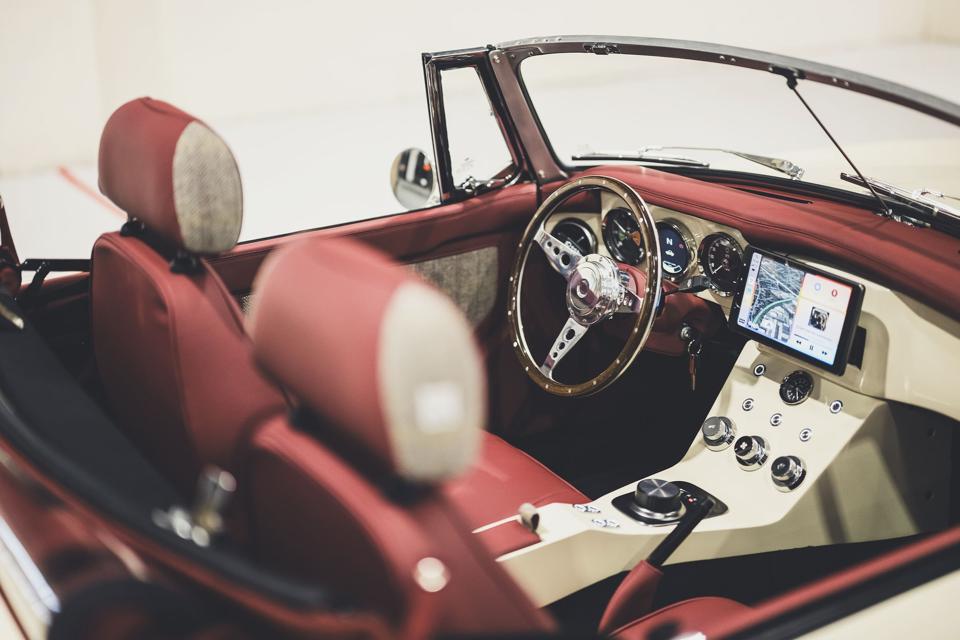From the outside, this little roadster more than strongly resembles an MG MGB from the 1960s. But underneath the classically inspired skin lurks an entirely new car—and a full EV, at that. Europeans might recognize the work of a British firm called RBW Electric Cars, which now plans to begin a customer run of cars built for American customers right here in the United States. Ahead of a debut at Monterey Car Week 2025, I took the first U.S. Roadster out for a quick spin around Los Angeles to experience this novel vision for custom EV builds.
RBW partnered with British Motor Heritage for the brand-new body shells and panels, using original factory tooling as the guide for construction out of modern materials. A new cradle then slides under the rear trunk area, complete with a single electric motor, axles and suspension components. Six lithium-ion battery modules bolt into the engine bay and the area formerly known as the transmission tunnel, for a total capacity of 50 kilowatt-hours that should result in about 150 to 200 miles of range (depending on driving style, of course).
That single motor comes courtesy of Continental Engineering Services, with a rating of up to 220 horsepower and 325 lb-ft of torque. But the convertible I drove only weighs 2,800 pounds, so RBW decided to halve output in the hopes of delivering a more refined experience behind the wheel. Yet even at “just” 163 lb-ft of instantaneously available torque—a more relevant figure than horsepower for electric motors—the faux-classic still delivers plenty of pep. And after all, how many full-throttle pulls in a modern electric hypercar before the fun factor wears off?
EV Power in a Familiar Form
The sensible throttle modulation almost matters more than all-out power, not to mention the top speed of just 90 miles per hour. Critically, nudging my toe onto the go pedal builds the sensation of acceleration with a steady and predictable ramp-up. It’s not an on-off switch by any means, and with the roof down, the more polished demeanor better matches the rest of the car.
Plus, the engineering and placement of mass results in a perfect 50:50 weight distribution, which rides low enough that the suspension can stay taut without ever becoming uncomfortable. Adjustable coilovers and double-wishbone suspension mean that an owner could theoretically dial up more harshness to improve cornering performance, but I enjoyed the ability to sense body roll through the plush seat. Lightweight cars can breathe better with the road, never sending crashy or jarring jolts into the cockpit. And the RBW loves to corner, even if maximum lateral g forces probably pale in comparison to more hardcore sports cars with much wider tires.
A mild column-mounted electric power steering system provides just enough assist to keep parking lots and other low-speed maneuvers easy and carefree, but still loads up the sublime Moto-Lita steering wheel with perceptible resistance to turn-in and easily managed unwinding on throttle, as well. Altogether, the RBW nails the cohesion of some playful dynamics within a stately character, without any off-putting attitude. Sure, the idea of more power always sounds better to confirmed speed freaks such as myself, but simply turning up the wick wouldn’t keep with the RBW ethos—and might throw that balance fully out of whack, in fact.
Other challenges cropped up in the development of this retro EV, though. The rear motor does use regenerative braking to recuperate electrons, but doing so only for the rear axle of a lightweight car occasionally caused strange dynamics. In the wet, excessive regen even led to occasional throttle liftoff oversteer, the infamous bane of air-cooled Porsches and other rear-engined sports cars. To cope with this, RBW programmed traction control software into the controller for the rear motor, which keeps any undesirable tendencies at bay.
Bringing British Engineering Stateside
Meanwhile, modern friction brakes work quite well to haul down speed—and this little MG twin even has ABS. Other modern details include a nine-inch Pioneer touchscreen with Wireless Apple CarPlay and Android Auto (which integrates into the dash far better than a Lotus Evora’s, of note). Climate control via knurgled knobs on the dash, plus a rotary shifter for selecting drive modes. And the wheels might resemble wire spokes but on closer examination, are actually forged aluminum pieces.
The lack of an internal-combustion engine means that any EV manufacturer needs to solve for additional NVH (noise, vibration, and harshness), so RBW went down the rabbit hole chasing creaks and rattles. To the point that any pin and screw received wrapping to prevent untoward annoyances. Similarly, I never noticed any suspension clunks or looseness in the chassis—all of which helps to impart the feeling of quality throughout the car.
All things considered, though, for a limited run of custom cars, the RBW U.S. Roadster’s pricetag of $139,000 sounds surprisingly low. A $1,000 deposit holds a spot, then clients can spec out their dream details. RBW hopes to starts American customer deliveries out of the new Danville, Virginia, facility starting in February of 2026. The first year, that run will cap at 60 cars, with hopes of expanding to 100 for 2027.
From 16 available standard exterior paint colors, in addition to plenty of personalization possible, I’d need to pick Racing Green Mica as the closest to quintessential British Racing Green as possible. Then tan leather and a black soft top—though an MGB GT coupe also sounds fairly nice, since I generally avoid convertibles. Then again, I can also readily admit the prospect of a Sunday cruise in this tiny electric drop-top sure sounds like a lot of near-silent fun.

